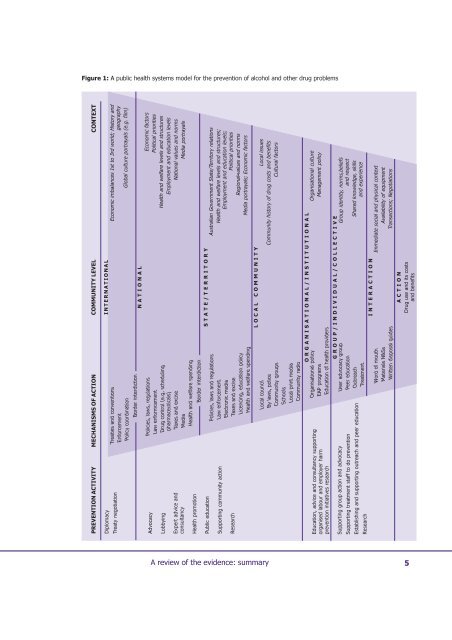Summary - Department of Health and Ageing
Summary - Department of Health and Ageing
Summary - Department of Health and Ageing
You also want an ePaper? Increase the reach of your titles
YUMPU automatically turns print PDFs into web optimized ePapers that Google loves.
The effectiveness <strong>of</strong> each intervention was assessed using a classification system <strong>of</strong> six<br />
criteria that summarise the status <strong>of</strong> research evidence for each strategy.<br />
O<br />
<br />
<br />
p<br />
<br />
Limited investigation<br />
No relevant effectiveness studies were located <strong>and</strong> there were no empirical or<br />
theoretical grounds suggesting the intervention might potentially impact the<br />
outcome. May also indicate that the evidence is inconsistent or contradictory.<br />
Evidence is contra-indicative<br />
The available evidence suggests that this strategy should not be used to prevent<br />
the outcome being targeted (e.g. drug supply, drug use, drug-related harm).<br />
Warrants further research.<br />
The strategy appears theoretically sound, or there is some promising evidence<br />
for its implementation or outcome, but further research is needed to evaluate<br />
its efficacy across larger groups or to define more clearly how it should be<br />
implemented.<br />
Evidence for implementation<br />
Published studies provide a sound theoretical rationale for the strategy <strong>and</strong> they<br />
clearly specify the way it should be implemented. In addition, they report that<br />
the strategy has been accepted within service delivery organisations; that<br />
recruitment <strong>of</strong> the target population has been sufficient to achieve a useful<br />
impact at the population health level; <strong>and</strong> that the strategy meets with adequate<br />
consumer approval, measured using indicators such as program retention. In<br />
cases where the strategy has few costs <strong>and</strong> obvious benefits, it may be<br />
supported for implementation. In other cases, wider implementation may await<br />
rigorous evaluation to establish outcome benefits.<br />
Evidence for outcomes<br />
The literature consistently reports positive outcomes from the use <strong>of</strong> the<br />
strategy in well-controlled interventions. Reported interventions were also <strong>of</strong><br />
sufficient scale to ensure positive outcomes when implemented at large-scale<br />
population level.<br />
Evidence for dissemination<br />
For strategies that meet the ‘evidence for outcomes’ criteria, the literature also<br />
reports that the strategy has had positive outcomes when delivered on a large<br />
scale by a wide range <strong>of</strong> service delivery agents, rather than by research teams.<br />
Where possible, the review also considers the cost-effectiveness <strong>of</strong> programs<br />
using these strategies.<br />
Each chapter that reviews interventions concludes with a ratings table using these ratings.<br />
Where possible, interventions for individual drug types are reviewed <strong>and</strong> rated but the<br />
literature does not always allow this specificity. Other areas (e.g. broad-based prevention<br />
strategies, Chapter 9) do not lend themselves, at all, to these ratings <strong>and</strong> strategies are<br />
summarised in terms <strong>of</strong> their applicability to drug use <strong>and</strong> harm.<br />
Where there has been any doubt about a rating the authors have erred on the side <strong>of</strong><br />
inclusivity.

















